|
|
|
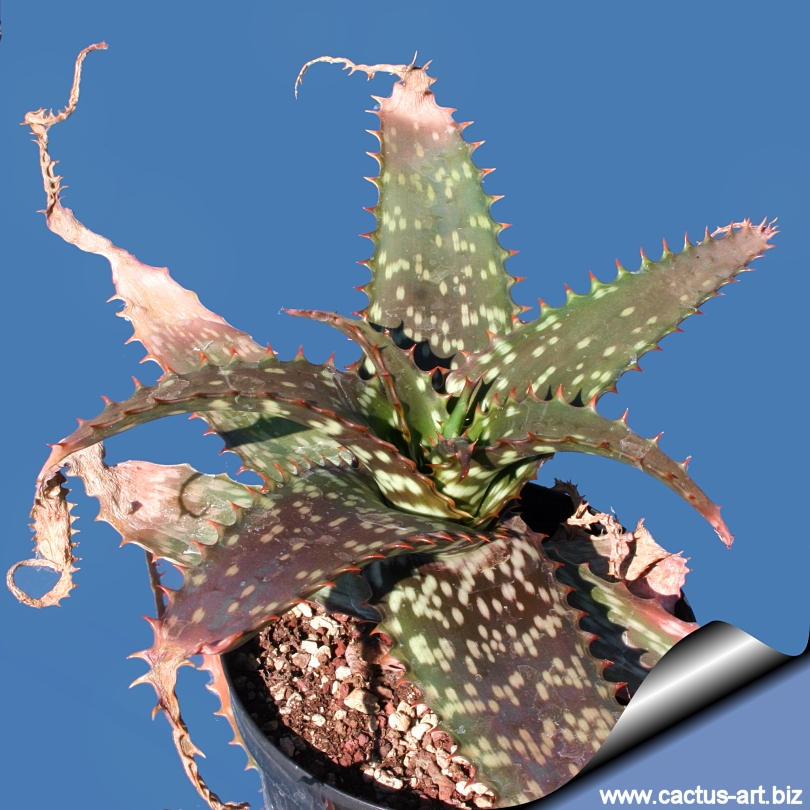
Aloe ammophila (Aloe
transvaalensis)
A characteristic (not a defect!) of this plant is that the
the tips of the leaves dry out naturally in summer and during time of
drought forming an attractive curl, so this should not be a cause for
concern in cultivation.
|
|
Description: Aloe ammophila
is a compact usually stemmless aloe with white translucent spots in the
leaves that form small groups from offsets at the base of plants. It
merely represents the Transvaal population of
Aloe zebrina
only distinguishable for some very subtle differences (longer leaves and
brighter coral-red flowers)
Rosettes: The main rosette gets up to 40 cm tall and just as
wide.
Stem: Plants are usually stemless or with a short stem up to 30
cm long.
Leaves: 15–25, densely clustered into a rosette, without petiole,
35-38 cm long, 6–7(-10) cm wide toward the base, lance-shaped, fleshy,
upper surface rather flat, dull dark green to powdery-glaucous with
often purplish hues in full sun, that bear large oblong whitish spots
more or less arranged in a series of irregular transverse bands, lower
surface convex, very powdery-glaucous with thick long brownish, horny,
deltoid, thorns (6–7 mm long, 10–16 mm Apart) on a lighter green edge.
When drought-stricken, the leaf tips tend to dry back and become
somewhat twisted. In some forms the white blotches become more
zebra-like streaks.
Flowers: Coral-red, bisexual
Inflorescence approx 60 cm tall with stalk copiously branched above the
middle
Blooming season: Mainly from February to May, but also June to
August.
Fruit: The fruit is a many-seeded capsule, dehiscing
loculicidally.
Seeds: ± 7 mm long, broadly winged, dark coloured, punctate.
|
|
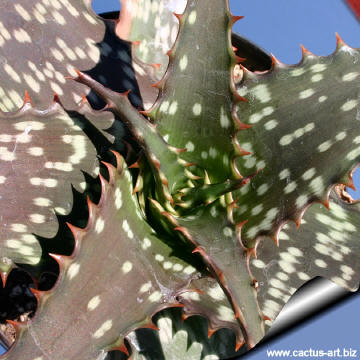 |
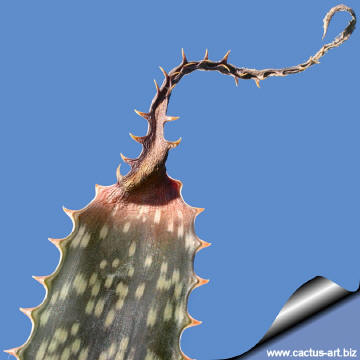 |
|
Someone don't regard Aloe
ammophila a good garden subject for its usually dried and twisted leaves
apex and indicate it as a hardly attractive species, while other love
this wild and apparently suffered appearance. |
|
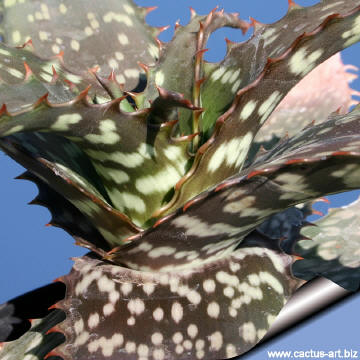
The leaf
margins are armed with prominent dark brown
teeth. |
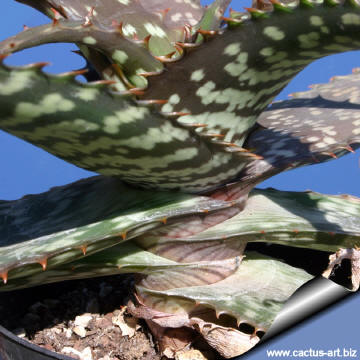
Plants are usually stemless or with
a short stem up to 30 cm long. |
|
Advertising
|
|
|
|
|
|
|
Family: Asphodelaceae
Scientific name:
Aloe zebrina Baker
In: Trans. Linn. Soc., ser. 2, Bot. 1: 264 (1878).
Origin: Ranges into Southern Afric,Namibia , Angola,
Botswana, Zimbabwe, Mozambiqu and may be present also in other parts of
tropical Africa.
Habitat: Grow singly or may form extensive
colonies in many different habitats comprising dry thickets, grasslands,
marshy meadows on river banks , open woodlands, rocky outcrops or on
almost bare ground. Altitude range 200–1600 m.
Conservation status: Listed in
CITES appendix 2.
Vernacular names
include: Zebra
Leaf Aloe and Tiger Aloe
Synonyms:
- Aloe ammophila Reynolds
- Aloe angustifolia Groenew
- Aloe bamangwatensis Schönland
- Aloe baumii Engl. & Gilg
- Aloe constricta Baker
- Aloe komatiensis Reynolds
- Aloe laxissima Reynolds
- Aloe lettyae Reynolds
- Aloe lugardiana Baker
- Aloe platyphylla Baker
- Aloe Kuntze
- Aloe vandermerwei Reynolds
|
|
|
|
Cultivation: Aloe
ammophila is easy to grow and adaptable, it suckers freely and
can form dense groups. It can be grown in large containers. Always use a
good quality, loamy sandy soil with plenty of drainage with chips at the
bottom of containers. It tolerates weekly watering in the summer; once a
month, or not at all in the colder months of December and January. Can
withstand long periods of drought, but they will thrive and flower more
profusely if watered in the correct season. Incorrect watering, poor
drainage or too much shade can lead to attack by pests and diseases.
It need
full sun to
partial shade, but plants grown in partial shade usually look
healthier and more
succulent. It is
however
very hardy when grown in full sun with the minimum
water. This aloe is very
tolerant of
drought, although the tips of the leaves may wither and curl during
hot,
dry periods. Supplemental
watering will help keeping the leaves plump and juicy.
Hardiness: When dry it can stand light frost but it is
damaged in
hard freezes, but recovers quickly. The leaf tips get damaged below
-2°C.
Maintenance: Removal of old flower
stalks; Divide the crowded
clumps periodically. During the
winter months, the plants should be grown cool to initiate flower
development (about 5-10°C ) It grows much better outdoors in spring
and summer.
Propagation: By
division of
offshoots that develop around the outside of the main rosette in
spring, thr cuttings must be dried out for at least 1 week
before planting in river sand. It can also be propagated or by seed
planted in autumn, in trays of coarse river sand. Fresh seeds
germinate quickly at 18°C.
Uses:
- Gardening: In mild climates it can
be cultivated outdoors for use in landscaping, it can be grown in
large, rocky, well-drained soil in gardens in drier areas. Aloe
zebrina adapts well to a variety of soils and climates, but will
grow best in regions with a climate close to that of its native
deserts not too cold, and not too wet.
It makes an excellent ground cover, grows best in a sunny position and
makes a long lasting cut flower. They grow slowly, but not agonisingly
so being able to increase their witdth by 10- 20 cm per year under
favourable conditions.
Photo of conspecific taxa, varieties, forms and
cultivars of plants
belonging to theAloe zebrina complex

 |
|